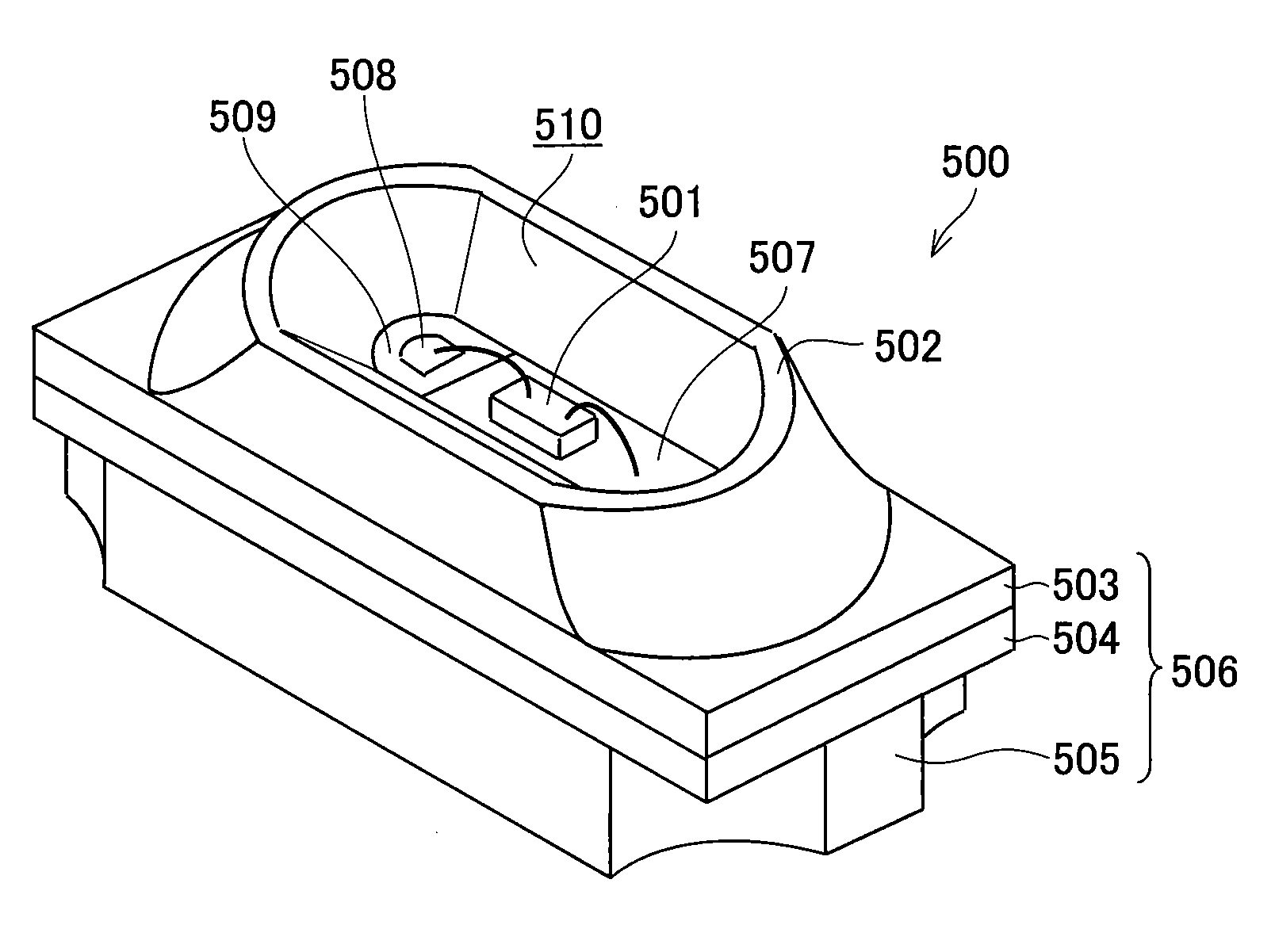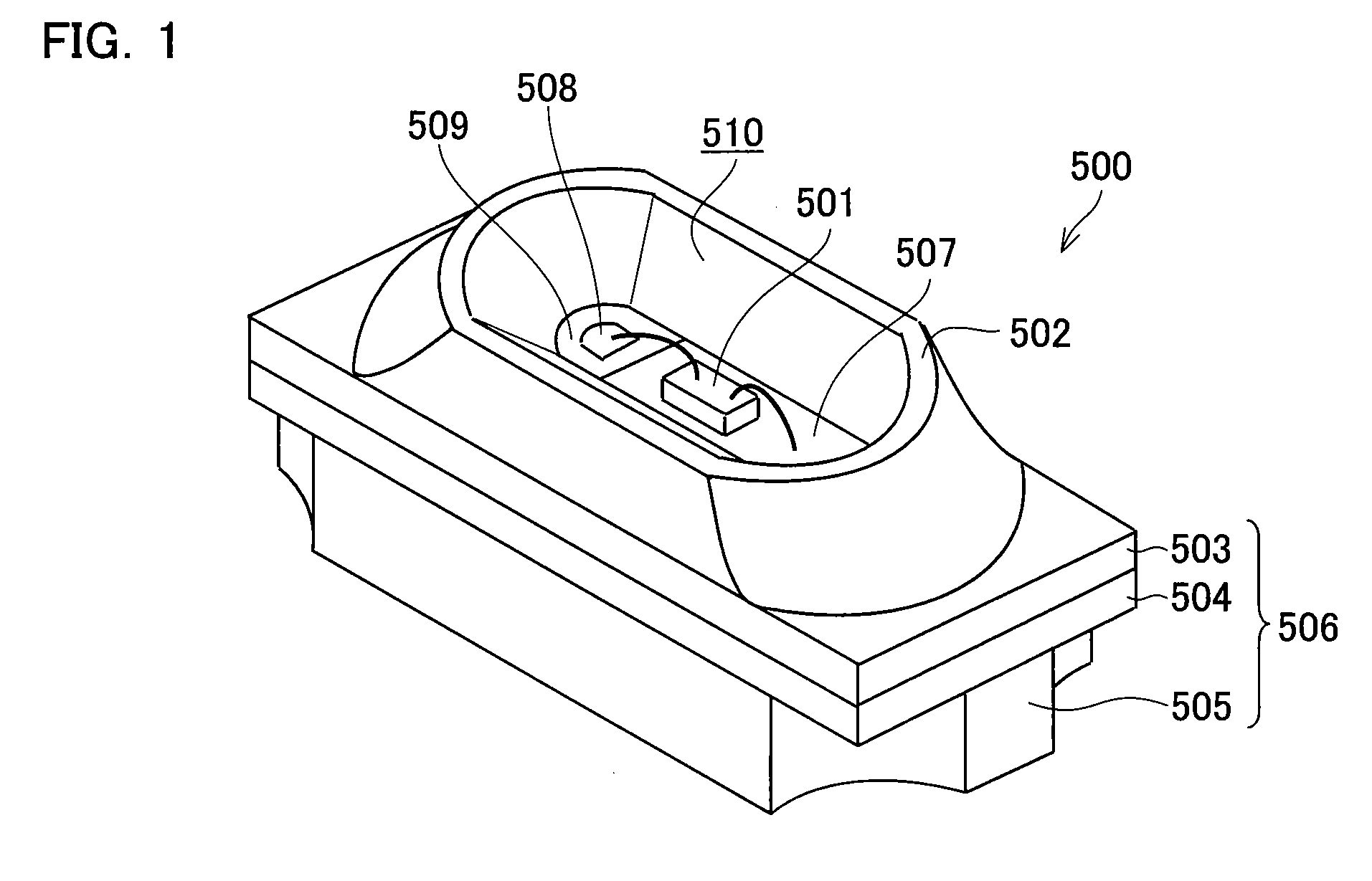Light emitting device and method of producing the same
a technology of light emitting devices and light sources, which is applied in the direction of semiconductor/solid-state device manufacturing, semiconductor devices, electrical devices, etc., can solve the problems of affecting the efficiency of light emission, and the damage of the element per se, so as to improve the intensity of light emitted, improve the efficiency of light emitted, and improve the effect of long-term reliability
- Summary
- Abstract
- Description
- Claims
- Application Information
AI Technical Summary
Benefits of technology
Problems solved by technology
Method used
Image
Examples
first embodiment
[0075]The following describes an embodiment of the present invention, with reference to FIGS. 1-5 and 38-41.
[0076]FIG. 1 is an oblique perspective view showing an exemplary structure of a light emitting device 500 of the present embodiment.
[0077]FIG. 2 is a sectional view showing a detailed structure of the light emitting device 500.
[0078]FIG. 3 shows a pattern of etching a metallic reflecting plate 502 and respective layers that constitute a multilayer substrate 506. FIG. 3(a) shows a first layer 521. FIG. 3(b) shows a second layer 522. FIG. 3(c) shows a third layer 523. FIG. 3(d) shows a fourth layer 524. FIG. 3(e) shows a fifth layer 525. FIG. 3(f) shows a sixth layer 526. FIG. 3(g) shows a seventh layer 527. FIG. 3(h) shows an eighth layer 528.
[0079]As shown in FIG. 1, the light emitting device 500 of the present embodiment includes an LED chip 501, which is mounted on the multilayer substrate 506, and the metallic reflecting plate 502. The metallic reflecting plate 502 stands a...
second embodiment
[0176]The following describes an embodiment of the present invention, with reference to FIGS. 6-14 and 23-26. For the convenience of explanation, components having the same functions as those of the components shown in the figures of the foregoing embodiments are given the same reference numbers, and description thereof is omitted.
[0177]A light emitting device 600 of the present embodiment produces an excellent effect of preventing light from leaking, in addition to the advantageous effects that the light emitting device 500 of First Embodiment produces. Further, the number of layers in a multilayer substrate 606 is reduced. The following description focuses on the structure that produces the advantageous effects and how it works to produce the advantageous effects.
[0178]In the light emitting device 500 of First Embodiment, a boundary surface between an insulating section 509 and a die-bonding-area / electrode section 507 forms a straight line when viewed from a direction vertical to ...
third embodiment
[0227]The following describes another embodiment of the present invention, with reference to FIGS. 17, 18, and 27-31. For the convenience of explanation, components having the same functions as those of the components shown in the figures of the foregoing embodiments are given the same reference numbers, and description thereof is omitted.
[0228]A light emitting device 700 according to the present embodiment includes a multilayer substrate same as the multilayer substrate 506 of the light emitting device 500 of First Embodiment discussed above.
[0229]As shown in FIG. 17, every electrode connected to an LED chip 701 and serving as an electrode terminal to supply driving current to the LED chip 701 is an island electrode. Specifically, a metallic reflecting plate 702 that reflects light from the LED chip 701 to guide the light to a light outgoing surface 513 provided in a direction in which light is emitted is electrically isolated from every electrode that supplies driving current to t...
PUM
 Login to View More
Login to View More Abstract
Description
Claims
Application Information
 Login to View More
Login to View More - R&D
- Intellectual Property
- Life Sciences
- Materials
- Tech Scout
- Unparalleled Data Quality
- Higher Quality Content
- 60% Fewer Hallucinations
Browse by: Latest US Patents, China's latest patents, Technical Efficacy Thesaurus, Application Domain, Technology Topic, Popular Technical Reports.
© 2025 PatSnap. All rights reserved.Legal|Privacy policy|Modern Slavery Act Transparency Statement|Sitemap|About US| Contact US: help@patsnap.com



